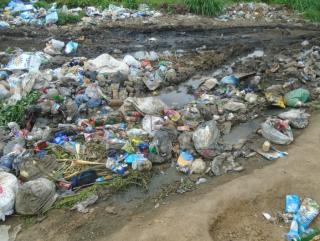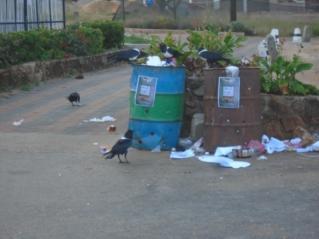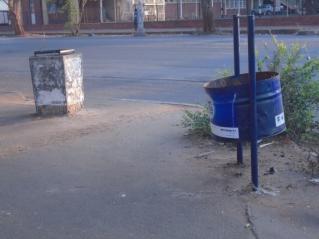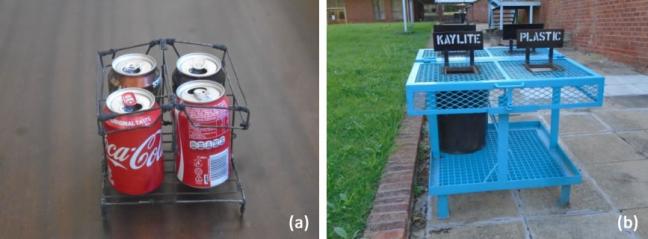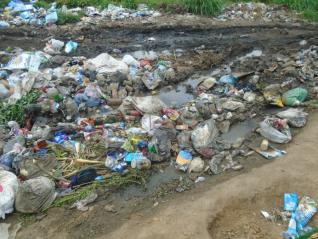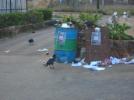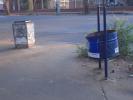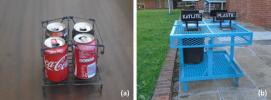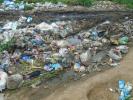In 2016, this researcher was approached by administration, at a time when the University of Zimbabwe was grappling with numerous problems in the area of Waste Management. Garbage tips had become a common feature in various places. Bins were not protected against scavengers (dogs, cats and birds). The task was then to design a mechanism that would help to contain the situation.
Observations showed all sorts of materials (glass, plastic, metal, paper, fabrics and wood) dumped in one place. Apart from protecting the bins against scavengers, it was therefore also necessary to sort all waste into various categories, thereby facilitating systematic collection. This would in turn help to recycle most of these materials into useful products. Having observed similar problems around various suburbs in Harare, regarding waste management, it is some of the ideas generated at the University of Zimbabwe that could profitably be shared with the City of Harare.
Conceptual/Theoretical framework
Conceptually and theoretically, it became necessary to examine specific pertinent issues within the following areas in order to put the whole study into appropriate context: Sustainable Development (The link between sustainable development and waste management); Community Development (The link between community development and waste management) and Appropriate Technology (The importance of appropriate technology in waste management).
Research questions
Taking from the research problem, the following research questions guided the study:
- What is the situation really like on the ground, regarding the nature and extent of the problem?
- What ideas could be adopted from existing solution?
- What solution could one eventually come up with?
- To what extent could the ideas generated at UZ be shared with the city of Harare, regarding Waste Management?
Methodology
In addressing the stated research questions, this study mainly involved observation of particular cases and capturing data on camera, in pictures and videos. In addition, all the design and development activities were reported and recorded in a design folio.
Results and findings
Taking from the research questions, results/findings were presented under the following:
- Situation, regarding nature and extent of problem;
- Ideas and possibilities from existing solutions;
- The eventual solution for UZ, and,
- Possibility of UZ and City of Harare sharing ideas on waste management.
Situation, regarding nature and extent of problem
Figure 1 Dogs and cats racking havoc during the night and birds taking over during the day.
Ideas and possibilities from existing solutions
Figure 2 Typical example of an existing bin systems in Harare
The eventual solution for UZ (From mock-up to prototype)
Figure 3 (a) Mock-up and (b) Prototype
Possibility of UZ and City of Harare sharing ideas on waste management.
Figure 4 Waste management problems also noted elsewhere in Harare
Conclusion and Discussion
From the results and findings of this study, it became clear that the University of Zimbabwe and the city of Harare had a lot in common, regarding the problem of waste management, where they appeared share several challenges in common. Therefore, the problem-solving experiences at the former are likely to be found helpful with the wider community of the latter, if appropriately tapped.
Bibliography
Alfaia, RGSM, Costa, AM, Campos, JC (2017) Municipal Solid Waste in Brazil. Waste Management and Research 35: 1195–1209.
Ali, M, Wang, W, Chaudhry, N. (2017) Hospital waste management in developing countries: A mini review. Waste Management and Research 35: 581–592.
Ananth, AP, Prashanthini, V, Visvanathan (2010) Healthcare waste management in Asia. Waste Management 30: 154–161.
Campos, JC, Costa, AM, Lourenço, AF. (2015) Evaluation of leachate from household solid waste and healthcare solid waste deposited in experimental cells. In: Cossu, R (ed.) Proceedings Sardinia Fifteenth International Waste Management and Landfill Symposium, Cagliari, 5–9 October, Italy, CISA Publisher.
Costa, AM, Alfaia, RCS, Campos, JC (2019) Landfill leachate treatment in Brazil – An overview. Journal of Environmental Management 232: 110–116.
Ferreira, JA, Bila, DM, Ritter, E. (2012) Chemical healthcare waste management in small Brazilian municipalities. Waste Management & Research 30: 1306–1311.
Ghosh, P, Thankur, IS, Kaushik, A (2017) Bioassays for toxicological risk assessment of landfill leachate: A review. Ecotoxicology and Environmental Safety 141: 259–270.
Levit, SM (2010) A literature review of effects of ammonia on fish. The Nature Conservancy. Available at: https://www.conservationgateway.org/ConservationByGeography/NorthAmeric… (accessed 16 July 2018).
Naveen, BP, Mahapatra, DM, Sitharam, TG. (2017) Physico-chemical and biological characterization of urban municipal landfill leachate. Environmental Pollution 220: 1–12.
Windfeld, ES, Brooks, MS-L (2015) Medical waste management – A review. Journal of Environmental Management 163: 98–108.
WHO (2018) World Health Organization. Health-care waste. Available at: https://www.who.int/news-room/fact-sheets/detail/health-care-waste (accessed 20 February 2018).

